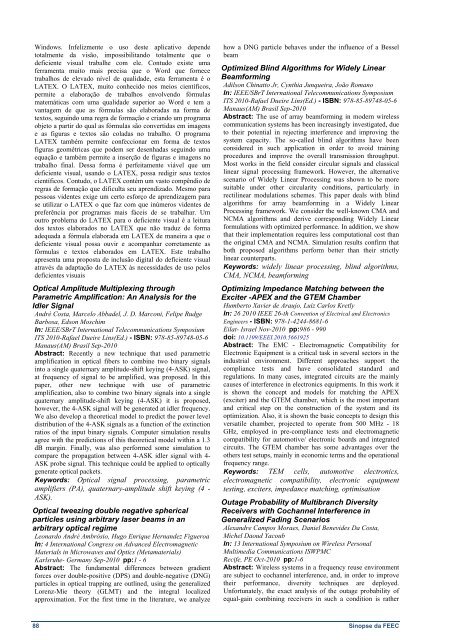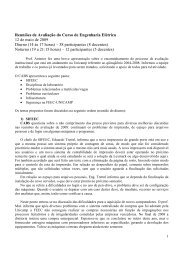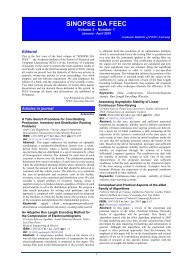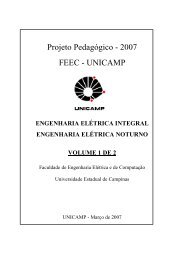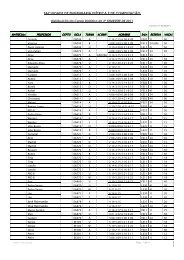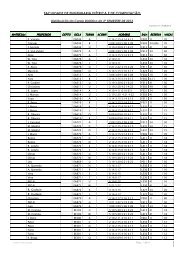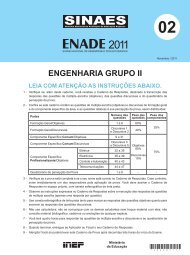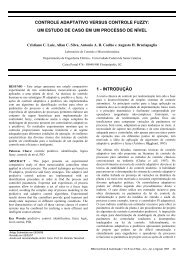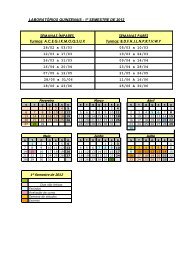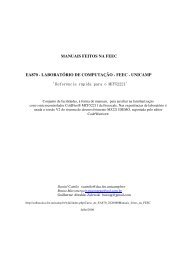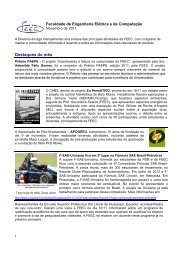sinopseV3n3.pdf - FEEC - Unicamp
sinopseV3n3.pdf - FEEC - Unicamp
sinopseV3n3.pdf - FEEC - Unicamp
Create successful ePaper yourself
Turn your PDF publications into a flip-book with our unique Google optimized e-Paper software.
Windows. Infelizmente o uso deste aplicativo depende<br />
totalmente da visão, impossibilitando totalmente que o<br />
deficiente visual trabalhe com ele. Contudo existe uma<br />
ferramenta muito mais precisa que o Word que fornece<br />
trabalhos de elevado nível de qualidade, esta ferramenta é o<br />
LATEX. O LATEX, muito conhecido nos meios científicos,<br />
permite a elaboração de trabalhos envolvendo fórmulas<br />
matemáticas com uma qualidade superior ao Word e tem a<br />
vantagem de que as fórmulas são elaboradas na forma de<br />
textos, seguindo uma regra de formação e criando um programa<br />
objeto a partir do qual as fórmulas são convertidas em imagens<br />
e as figuras e textos são coladas no trabalho. O programa<br />
LATEX também permite confeccionar em forma de textos<br />
figuras geométricas que podem ser desenhadas seguindo uma<br />
equação e também permite a inserção de figuras e imagens no<br />
trabalho final. Dessa forma é perfeitamente viável que um<br />
deficiente visual, usando o LATEX, possa redigir seus textos<br />
científicos. Contudo, o LATEX contém um vasto compêndio de<br />
regras de formação que dificulta seu aprendizado. Mesmo para<br />
pessoas videntes exige um certo esforço de aprendizagem para<br />
se utilizar o LATEX o que faz com que inúmeros videntes de<br />
preferência por programas mais fáceis de se trabalhar. Um<br />
outro problema do LATEX para o deficiente visual é a leitura<br />
dos textos elaborados no LATEX que não traduz de forma<br />
adequada a fórmula elaborada em LATEX de maneira a que o<br />
deficiente visual possa ouvir e acompanhar corretamente as<br />
fórmulas e textos elaborados em LATEX. Este trabalho<br />
apresenta uma proposta de inclusão digital do deficiente visual<br />
através da adaptação do LATEX às necessidades de uso pelos<br />
deficientes visuais<br />
Optical Amplitude Multiplexing through<br />
Parametric Amplification: An Analysis for the<br />
Idler Signal<br />
André Costa, Marcelo Abbadel, J. D. Marconi, Felipe Rudge<br />
Barbosa, Edson Moschim<br />
In: IEEE/SBrT International Telecommunications Symposium<br />
ITS 2010-Rafael Dueire Lins(Ed.) - ISBN: 978-85-89748-05-6<br />
Manaus(AM) Brasil Sep-2010<br />
Abstract: Recently a new technique that used parametric<br />
amplification in optical fibers to combine two binary signals<br />
into a single quaternary amplitude-shift keying (4-ASK) signal,<br />
at frequency of signal to be amplified, was proposed. In this<br />
paper, other new technique with use of parametric<br />
amplification, also to combine two binary signals into a single<br />
quaternary amplitude-shift keying (4-ASK) it is proposed,<br />
however, the 4-ASK signal will be generated at idler frequency.<br />
We also develop a theoretical model to predict the power level<br />
distribution of the 4-ASK signals as a function of the extinction<br />
ratios of the input binary signals. Computer simulation results<br />
agree with the predictions of this theoretical model within a 1.3<br />
dB margin. Finally, was also performed some simulation to<br />
compare the propagation between 4-ASK idler signal with 4-<br />
ASK probe signal. This technique could be applied to optically<br />
generate optical packets.<br />
Keywords: Optical signal processing, parametric<br />
amplifiers (PA), quaternary-amplitude shift keying (4 -<br />
ASK).<br />
Optical tweezing double negative spherical<br />
particles using arbitrary laser beams in an<br />
arbitrary optical regime<br />
Leonardo André Ambrósio, Hugo Enrique Hernandez Figueroa<br />
In: 4 International Congress on Advanced Electromagnetic<br />
Materials in Microwaves and Optics (Metamaterials)<br />
Karlsruhe- Germany Sep-2010 pp:1 - 6<br />
Abstract: The fundamental differences between gradient<br />
forces over double-positive (DPS) and double-negative (DNG)<br />
particles in optical trapping are outlined, using the generalized<br />
Lorenz-Mie theory (GLMT) and the integral localized<br />
approximation. For the first time in the literature, we analyze<br />
how a DNG particle behaves under the influence of a Bessel<br />
beam<br />
Optimized Blind Algorithms for Widely Linear<br />
Beamforming<br />
Adilson Chinatto Jr, Cynthia Junqueira, João Romano<br />
In: IEEE/SBrT International Telecommunications Symposium<br />
ITS 2010-Rafael Dueire Lins(Ed.) - ISBN: 978-85-89748-05-6<br />
Manaus(AM) Brasil Sep-2010<br />
Abstract: The use of array beamforming in modern wireless<br />
communication systems has been increasingly investigated, due<br />
to their potential in rejecting interference and improving the<br />
system capacity. The so-called blind algorithms have been<br />
considered in such application in order to avoid training<br />
procedures and improve the overall transmission throughput.<br />
Most works in the field consider circular signals and classical<br />
linear signal processing framework. However, the alternative<br />
scenario of Widely Linear Processing was shown to be more<br />
suitable under other circularity conditions, particularly in<br />
rectilinear modulations schemes. This paper deals with blind<br />
algorithms for array beamforming in a Widely Linear<br />
Processing framework. We consider the well-known CMA and<br />
NCMA algorithms and derive corresponding Widely Linear<br />
formulations with optimized performance. In addition, we show<br />
that their implementation requires less computational cost than<br />
the original CMA and NCMA. Simulation results confirm that<br />
both proposed algorithms perform better than their strictly<br />
linear counterparts.<br />
Keywords: widely linear processing, blind algorithms,<br />
CMA, NCMA, beamforming<br />
Optimizing Impedance Matching between the<br />
Exciter -APEX and the GTEM Chamber<br />
Humberto Xavier de Araujo, Luiz Carlos Kretly<br />
In: 26 2010 IEEE 26-th Convention of Electrical and Electronics<br />
Engineers - ISBN: 978-1-4244-8681-6<br />
Eilat- Israel Nov-2010 pp:986 - 990<br />
doi: 10.1109/EEEI.2010.5661925<br />
Abstract: The EMC - Electromagnetic Compatibility for<br />
Electronic Equipment is a critical task in several sectors in the<br />
industrial environment. Different approaches support the<br />
compliance tests and have consolidated standard and<br />
regulations. In many cases, integrated circuits are the mainly<br />
causes of interference in electronics equipments. In this work it<br />
is shown the concept and models for matching the APEX<br />
(exciter) and the GTEM chamber, which is the most important<br />
and critical step on the construction of the system and its<br />
optimization. Also, it is shown the basic concepts to design this<br />
versatile chamber, projected to operate from 500 MHz - 18<br />
GHz, employed in pre-compliance tests and electromagnetic<br />
compatibility for automotive/ electronic boards and integrated<br />
circuits. The GTEM chamber has some advantages over the<br />
others test setups, mainly in economic terms and the operational<br />
frequency range.<br />
Keywords: TEM cells, automotive electronics,<br />
electromagnetic compatibility, electronic equipment<br />
testing, exciters, impedance matching, optimisation<br />
Outage Probability of Multibranch Diversity<br />
Receivers with Cochannel Interference in<br />
Generalized Fading Scenarios<br />
Alexandre Campos Moraes, Daniel Benevides Da Costa,<br />
Michel Daoud Yacoub<br />
In: 13 International Symposium on Wireless Personal<br />
Multimedia Communications ISWPMC<br />
Recife, PE Oct-2010 pp:1-6<br />
Abstract: Wireless systems in a frequency reuse environment<br />
are subject to cochannel interference, and, in order to improve<br />
their performance, diversity techniques are deployed.<br />
Unfortunately, the exact analysis of the outage probability of<br />
equal-gain combining receivers in such a condition is rather<br />
88 Sinopse da <strong>FEEC</strong>


